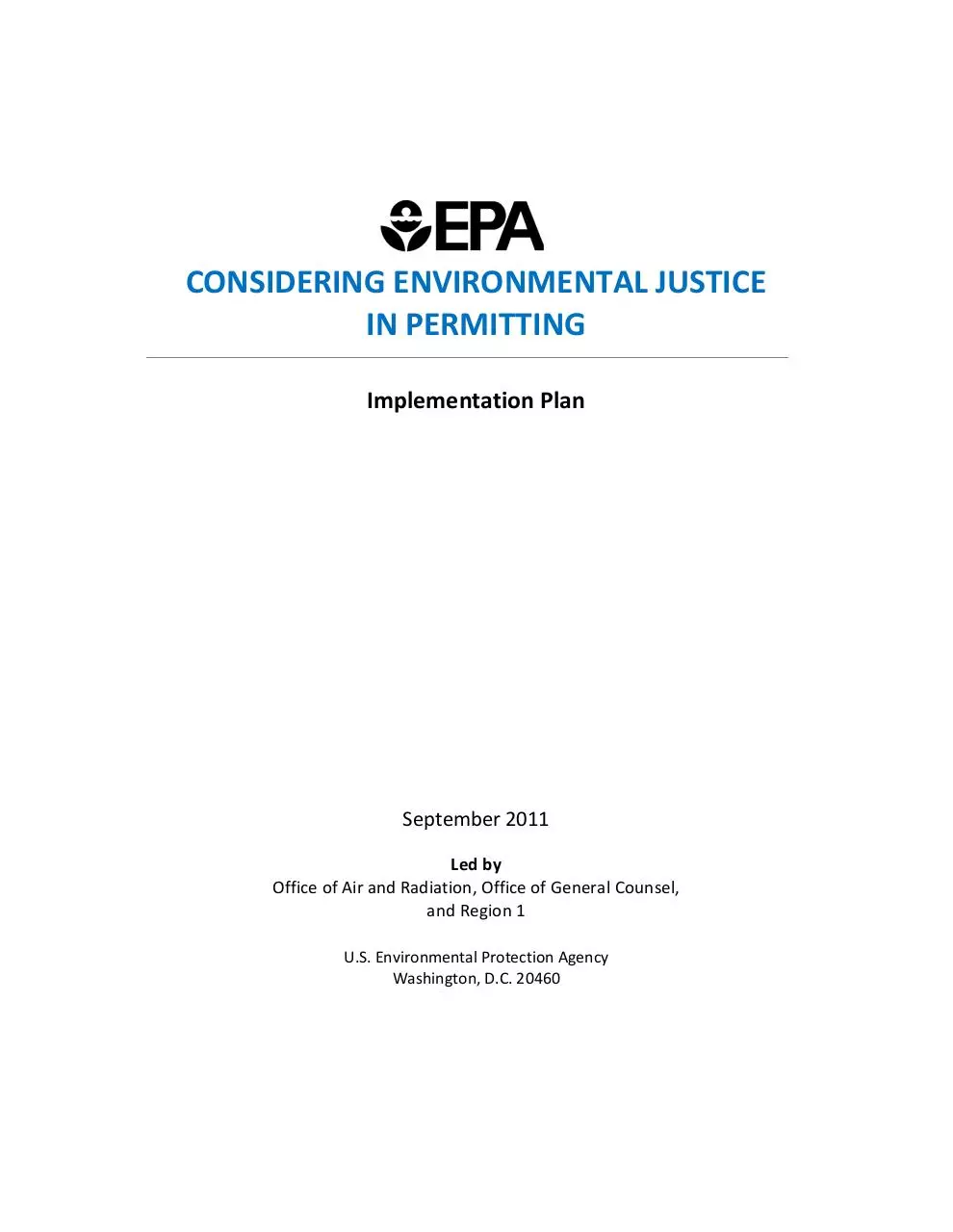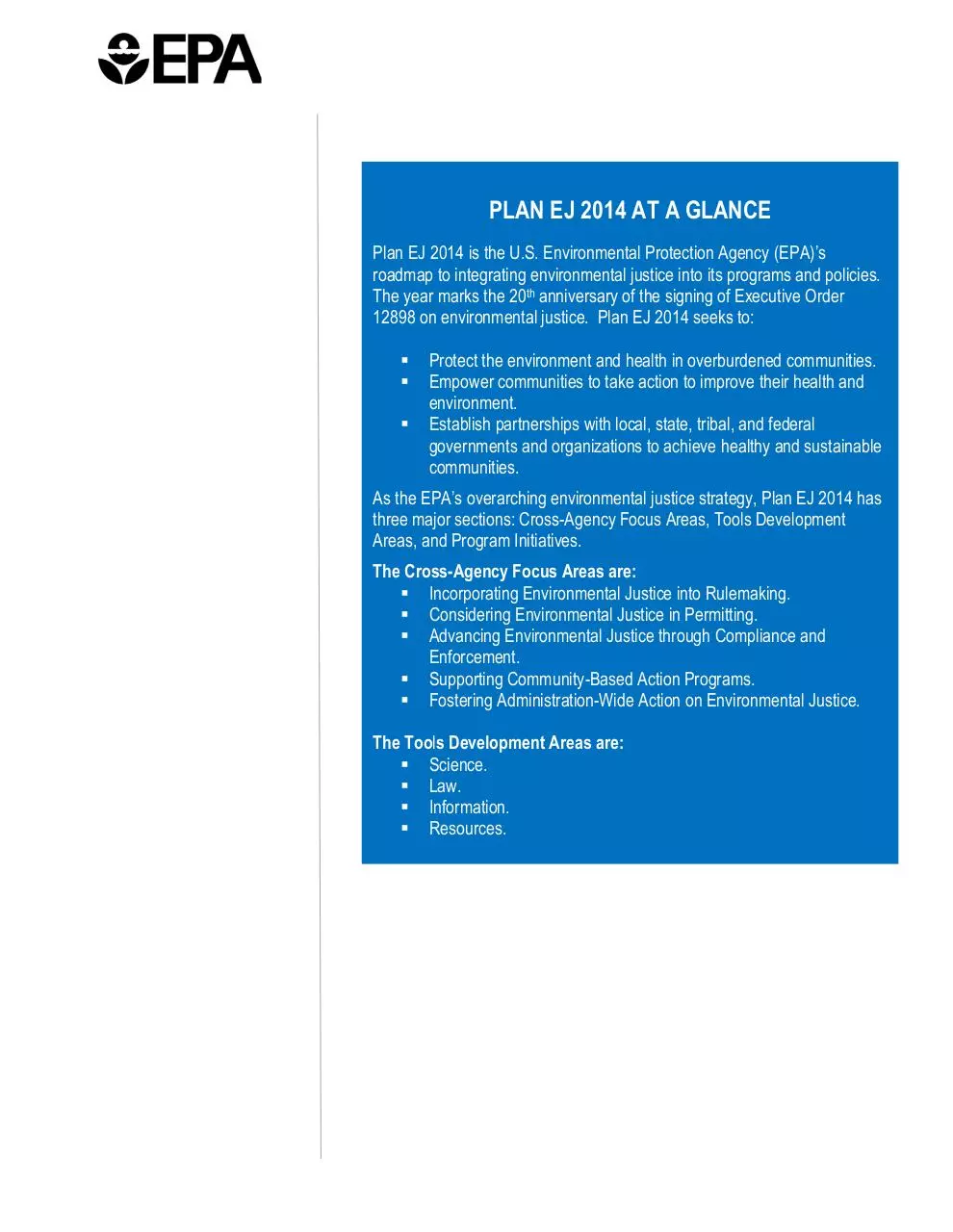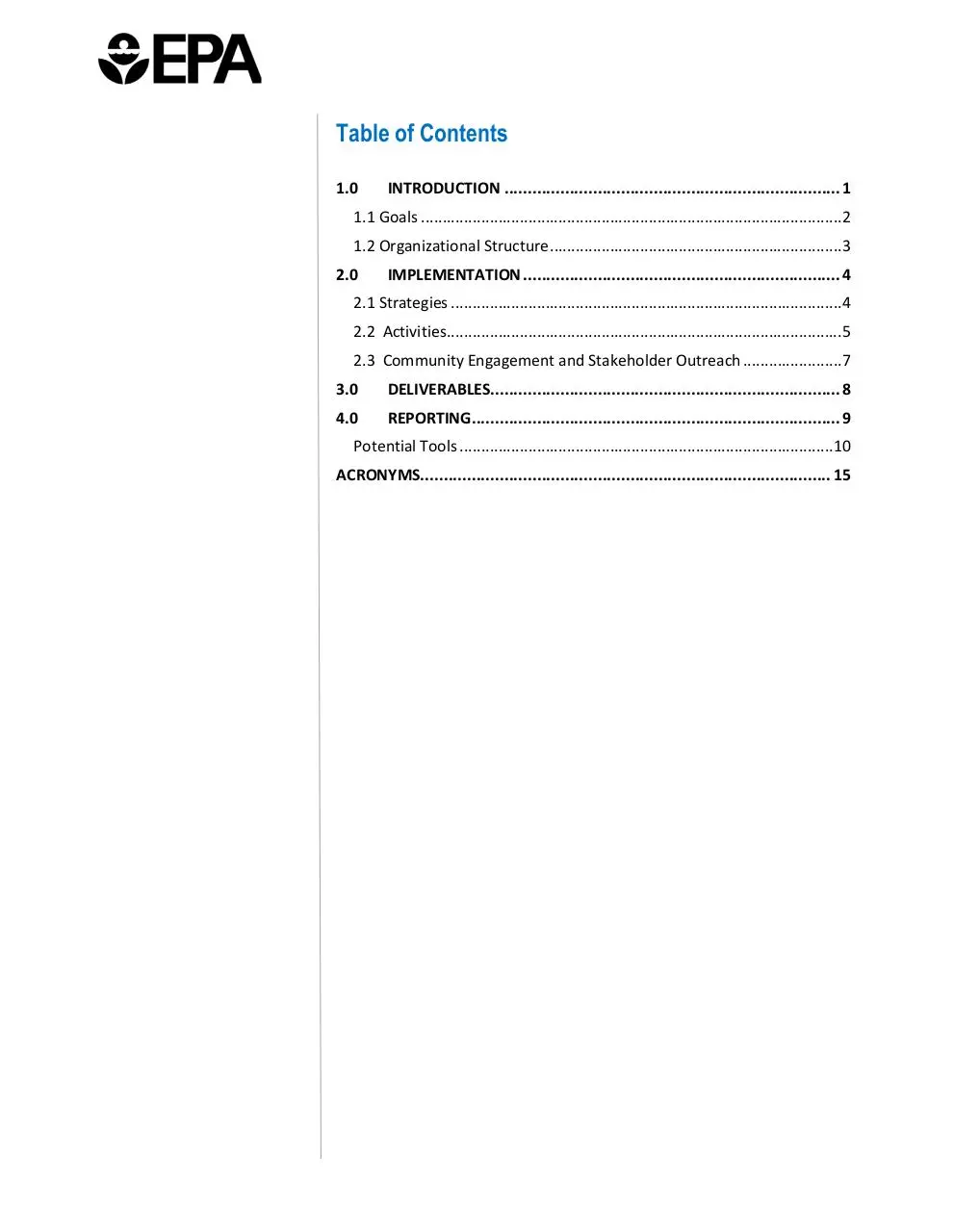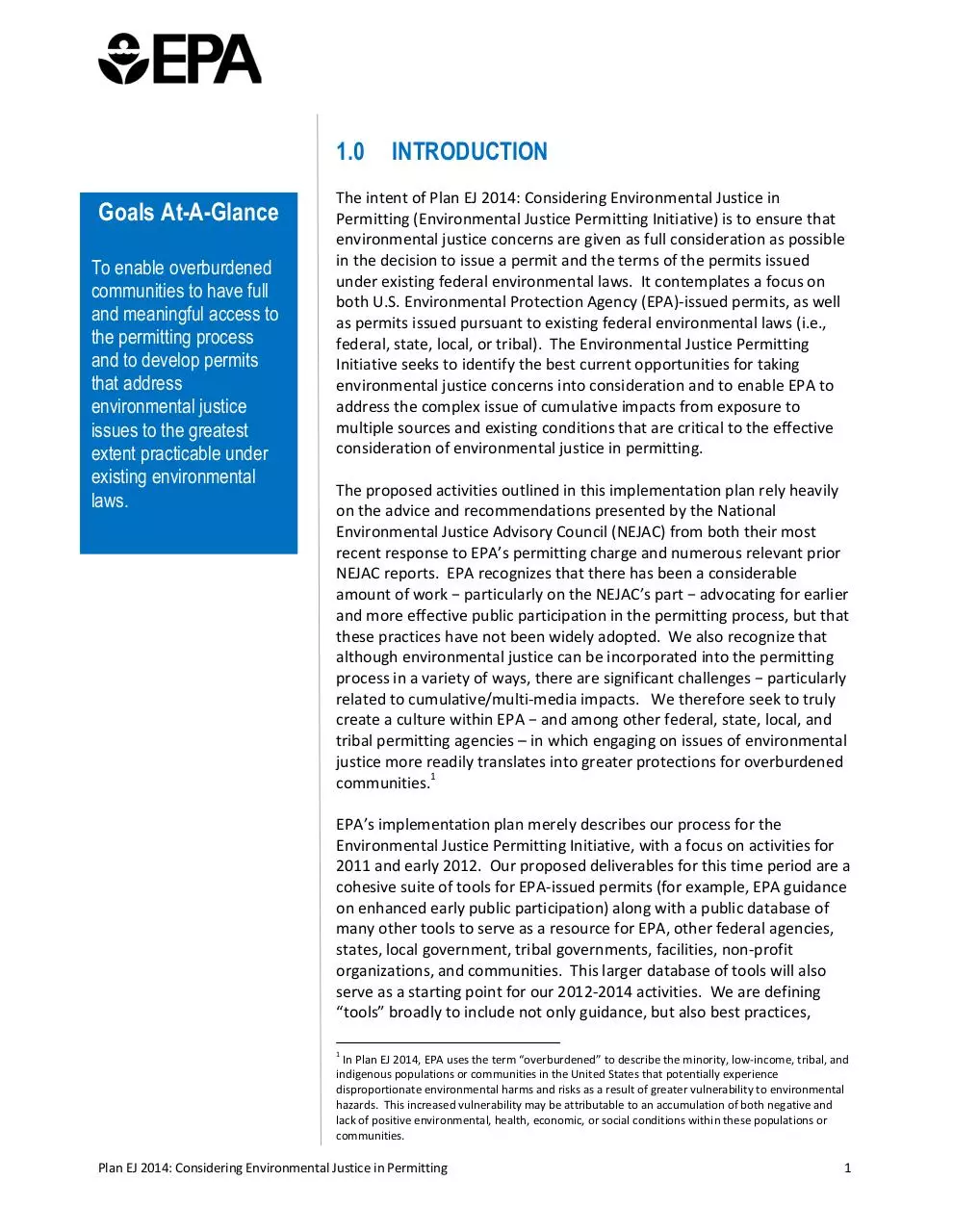plan ej permitting 2011 09 (PDF)
File information
Title: Plan EJ 2014: Considering Environmental Justice in Permitting
Author: EPA/OECA/Office of Environmental Justice
This PDF 1.6 document has been generated by Microsoft® Office Word 2007, and has been sent on pdf-archive.com on 27/07/2016 at 23:20, from IP address 65.78.x.x.
The current document download page has been viewed 433 times.
File size: 824.01 KB (20 pages).
Privacy: public file





File preview
Insert Cover
CONSIDERING ENVIRONMENTAL JUSTICE
IN PERMITTING
Implementation Plan
September 2011
Led by
Office of Air and Radiation, Office of General Counsel,
and Region 1
U.S. Environmental Protection Agency
Washington, D.C. 20460
PLAN EJ 2014 AT A GLANCE
Plan EJ 2014 is the U.S. Environmental Protection Agency (EPA)’s
roadmap to integrating environmental justice into its programs and policies.
The year marks the 20th anniversary of the signing of Executive Order
12898 on environmental justice. Plan EJ 2014 seeks to:
Protect the environment and health in overburdened communities.
Empower communities to take action to improve their health and
environment.
Establish partnerships with local, state, tribal, and federal
governments and organizations to achieve healthy and sustainable
communities.
As the EPA’s overarching environmental justice strategy, Plan EJ 2014 has
three major sections: Cross-Agency Focus Areas, Tools Development
Areas, and Program Initiatives.
The Cross-Agency Focus Areas are:
Incorporating Environmental Justice into Rulemaking.
Considering Environmental Justice in Permitting.
Advancing Environmental Justice through Compliance and
Enforcement.
Supporting Community-Based Action Programs.
Fostering Administration-Wide Action on Environmental Justice.
The Tools Development Areas are:
Science.
Law.
Information.
Resources.
Table of Contents
1.0
INTRODUCTION ........................................................................ 1
1.1 Goals ..................................................................................................2
1.2 Organizational Structure ....................................................................3
2.0
IMPLEMENTATION .................................................................... 4
2.1 Strategies ...........................................................................................4
2.2 Activities............................................................................................5
2.3 Community Engagement and Stakeholder Outreach .......................7
3.0
DELIVERABLES........................................................................... 8
4.0
REPORTING............................................................................... 9
Potential Tools .......................................................................................10
ACRONYMS........................................................................................ 15
1.0
Goals At-A-Glance
To enable overburdened
communities to have full
and meaningful access to
the permitting process
and to develop permits
that address
environmental justice
issues to the greatest
extent practicable under
existing environmental
laws.
INTRODUCTION
The intent of Plan EJ 2014: Considering Environmental Justice in
Permitting (Environmental Justice Permitting Initiative) is to ensure that
environmental justice concerns are given as full consideration as possible
in the decision to issue a permit and the terms of the permits issued
under existing federal environmental laws. It contemplates a focus on
both U.S. Environmental Protection Agency (EPA)-issued permits, as well
as permits issued pursuant to existing federal environmental laws (i.e.,
federal, state, local, or tribal). The Environmental Justice Permitting
Initiative seeks to identify the best current opportunities for taking
environmental justice concerns into consideration and to enable EPA to
address the complex issue of cumulative impacts from exposure to
multiple sources and existing conditions that are critical to the effective
consideration of environmental justice in permitting.
The proposed activities outlined in this implementation plan rely heavily
on the advice and recommendations presented by the National
Environmental Justice Advisory Council (NEJAC) from both their most
recent response to EPA’s permitting charge and numerous relevant prior
NEJAC reports. EPA recognizes that there has been a considerable
amount of work − particularly on the NEJAC’s part − advocating for earlier
and more effective public participation in the permitting process, but that
these practices have not been widely adopted. We also recognize that
although environmental justice can be incorporated into the permitting
process in a variety of ways, there are significant challenges − particularly
related to cumulative/multi-media impacts. We therefore seek to truly
create a culture within EPA − and among other federal, state, local, and
tribal permitting agencies – in which engaging on issues of environmental
justice more readily translates into greater protections for overburdened
communities.1
EPA’s implementation plan merely describes our process for the
Environmental Justice Permitting Initiative, with a focus on activities for
2011 and early 2012. Our proposed deliverables for this time period are a
cohesive suite of tools for EPA-issued permits (for example, EPA guidance
on enhanced early public participation) along with a public database of
many other tools to serve as a resource for EPA, other federal agencies,
states, local government, tribal governments, facilities, non-profit
organizations, and communities. This larger database of tools will also
serve as a starting point for our 2012-2014 activities. We are defining
“tools” broadly to include not only guidance, but also best practices,
1
In Plan EJ 2014, EPA uses the term “overburdened” to describe the minority, low-income, tribal, and
indigenous populations or communities in the United States that potentially experience
disproportionate environmental harms and risks as a result of greater vulnerability to environmental
hazards. This increased vulnerability may be attributable to an accumulation of both negative and
lack of positive environmental, health, economic, or social conditions within these populations or
communities.
Plan EJ 2014: Considering Environmental Justice in Permitting
1
templates, reports, checklists, case studies, mapping and screening tools,
protocols, trainings, sample language, and other resources.
Appendix A of this document contains our initial draft list of potential
tools, but the list is neither prescriptive nor exhaustive. Over the next
few years, we may decide not to develop some of these potential tools;
similarly, we may decide to add new potential tools to the list as we
continue to gather ideas and suggestions. Throughout the process,
however, we will be listening to the ideas and experiences of all
interested stakeholders, in order to leverage the successes and seize on
the good work that is already occurring on this topic.
1.1 Goals
The overarching goals of this Plan are to enable overburdened
communities to have full and meaningful access to the permitting process
and to develop permits that address environmental justice issues to the
greatest extent practicable.
To achieve our goals, the Environmental Justice Permitting Initiative will
“*i+dentify and develop tools to support the consideration of
environmental justice during implementation of permitting programs” to
reduce “exposures for those at the greatest risk,” as stated in the Fiscal
Year (FY) 2011-2015 EPA Strategic Plan, Cross-Cutting Fundamental
Strategy: Working for Environmental Justice and Children’s Health
(Strategic Plan).2
Our goals help to fulfill:
Executive Order 12898, “Federal Actions to Address Environmental
Justice In Minority Populations and Low-Income Populations,” which
tasks each federal agency with “achieving environmental justice as
part of its mission by identifying and addressing, as appropriate,
disproportionately high and adverse human health or environmental
effects of its programs, policies, and activities on minority populations
and low-income population.”3
The Administrator’s priority of Expanding the Conversation on
Environmentalism and Working for Environmental Justice, which
heralds “a new era of outreach and protection for communities
historically underrepresented in EPA decision-making” and calls for
“includ[ing] environmental justice principles in all of our decisions.”4
EPA’s mission to protect human health and the environment.
2
U.S. Environmental Protection Agency, FY 2011-2015 EPA Strategic Plan: Achieving Our Vision,
September 30, 2010. Available at: http://www.epa.gov/planandbudget/strategicplan.html.
3
Clinton, William J., Executive Order 12898, “Federal Actions to Address Environmental Justice in
Minority Populations and Low-Income Populations,” February 11, 1994, Federal Register 59, No. 32:
7629.
4
Jackson, Lisa P., “Seven Priorities for EPA’s Future.” January 12, 2010. Available at:
http://blog.epa.gov/administrator/2010/01/12/seven-priorities-for-epas-future/.
Plan EJ 2014: Considering Environmental Justice in Permitting
2
1.2 Organizational Structure
The success of this Environmental Justice Permitting Initiative will depend
on participation from many offices within EPA, both at Headquarters and
the regions, as well as numerous external stakeholders (see Section 2.3,
Community Engagement and Stakeholder Outreach).
The Office of Air and Radiation has been designated the Headquarters
lead. The Office of General Counsel has agreed to act as co-lead. Region
1 is the Lead Region. Staff and managers from these three offices, with
guidance from the Office of Enforcement and Compliance
Assurance/Office of Environmental Justice, have formed a Steering
Committee to manage the Environmental Justice Permitting Initiative.
The Steering Committee is chaired by the Principal Deputy Assistant
Administrator, Office of Air and Radiation; the Associate General Counsel,
Cross-Cutting Issues Law Office, Office of General Counsel; and the
Deputy Regional Administrator, Region 1.
The Environmental Justice Permitting Initiative has a small group
composed of key senior EPA Headquarters and regional leaders (Senior
Leaders) to provide high level recommendations as well as a cross-Agency
workgroup of EPA Headquarters and regional staff to do the work. The
workgroup contains staff from every EPA region, as well as staff from the
Office of Air and Radiation, the Office of Enforcement and Compliance
Assurance, the Office of Environmental Information, the Office of General
Counsel, the Office of International and Tribal Affairs, the Office of
Research and Development, the Office of Solid Waste and Emergency
Response, and the Office of Water.
Staff support for the Environmental Justice Permitting Initiative is
provided the Office of Policy Analysis and Review, Office of Air and
Radiation.
Plan EJ 2014: Considering Environmental Justice in Permitting
3
2.0
IMPLEMENTATION
Conducting Public Participation to Develop
Permitting Tools
The Environmental Justice and Permitting Initiative
Workgroup (Workgroup) is exploring ways to enable
overburdened communities to have full and meaningful
access to the permitting process and to ensure that the
Agency develops permits that address environmental
justice issues to the greatest extent practicable. As part
of this effort, the Workgroup is conducting extensive
public outreach to identify best practices and needed
tools, such as guidance, checklists, reports, case
studies, mapping tools, and trainings. In June 2011, the
Workgroup conducted listening sessions for a host of
stakeholder groups, including state and local
governments, business and industry, environmental
groups, tribes, and community groups. One listening
session was conducted entirely in Spanish.
The Workgroup repeatedly heard about the need for
early and meaningful public engagement. Its members
were impressed and inspired by the information they
received about Connecticut, Illinois, and Pennsylvania’s
Enhanced/Environmental Justice Public Participation
Policies. The Workgroup is drafting guidance to enhance
the public participation process for EPA-issued
permits and strongly encourages facilities to host preapplication meetings with local communities. The
Workgroup’s hope is that this guidance will be used
across the EPA, as well as by other federal agencies
and states in their respective permit processes.
The strategies and activities outlined below describe the
charge to the Environmental Justice Permitting Workgroup
over the next several years. In the meantime, we strongly
encourage offices and individuals at EPA and external to
the Agency to continue their ongoing practice of furthering
integration of environmental justice into the permitting
process (e.g., regional review of state permits). Indeed, we
encourage offices and individuals to share new issues,
potential tools, and recommendations with the workgroup
and communicate lessons learned.
2.1 Strategies
Strategies to achieve the goals of this implementation plan
are specific to each goal:
Strategy 1: Develop tools that will enhance the ability of
overburdened communities to participate fully and
meaningfully in the permitting process.
These tools will focus on ensuring that overburdened
communities are fully informed about the potential
impacts of permitted activities and understand the
information they receive. In addition, we will explore ways
of promoting regular dialogue between overburdened
communities and the regulated facilities at all stages of the
permitting process, including early involvement, and after
a permit has been issued.
Strategy 2: Concurrently with Strategy 1, develop tools to assist
permitting authorities to meaningfully address environmental justice in
permitting decisions.
These tools will focus on how environmental justice can be incorporated
into the permitting process, including the range of potential permitting
measures that can be used to avoid or reduce potential environmental
justice effects.
Strategy 3: Implement these tools at EPA and work with others to do
the same.
We will first focus on implementing tools related to EPA-issued permits.
Thereafter, we will engage in supporting and encouraging other federal
agencies, as well as state, local, and tribal permitting authorities, to
develop environmental justice strategies for their environmental
permitting decisions.
Plan EJ 2014: Considering Environmental Justice in Permitting
4
2.2 Activities
All of the activities below support our goal to develop and implement
tools to better enable overburdened communities to have full and
meaningful access to the permitting process and for permits to address
environmental justice issues to the greatest extent practicable. These
tools include guidance, best practices, templates, reports, checklists, case
studies, mapping and screening tools, protocols, trainings, and sample
language.
Activity 1: Conduct initial internal research to begin to create a
preliminary list of potential tools and finalize the implementation plan
(March-June 2011, Completed).
Activity 1.1: Conduct an initial literature review − including a review
of previous NEJAC papers, publications, and other recommendations
− to identify an initial list of existing and needed tools (Completed,
see Appendix A).
Activity 1.2: Convene a cross-Agency workgroup. The workgroup
met for the first time on March 7, 2011, and will carry out the
proposed activities in this implementation plan (Completed).
Activity 1.3: Review and evaluate the permitting process for a
minimum of three federal permits with environmental justice
considerations, for use as case studies to identify existing and
needed tools5 (Completed). The workgroup reviewed the permitting
process for three federal permits and will continue to review other
permits to solicit lessons learned and guide our next steps.
Activity 1.4: Coordinate overlapping strategies with other Plan EJ
2014 elements and consider integrating and leveraging activities
between them (Ongoing).
Activity 1.5: Issue the final implementation plan (Completed).
Activity 2: Solicit initial existing and recommended tools from internal
and external stakeholders (March-June 2011).
Individual EPA programs and regions, as well as other federal agencies,
states, local agencies, and tribal governments, have already developed
and implemented numerous tools that consider environmental justice
issues during the permitting process. These entities as well as community
and advocacy groups, industry and trade organizations, and experts have
first-hand experience and knowledge about the relevant issues and ideas
for what tools are needed. Outreach to these experts provides the
workgroup an important opportunity to gather the tools and begin to
identify the most effective and replicable ones.
In addition to reviewing all of the comments submitted during the formal
public comment period (which ended Friday, April 29, 2011), the
5
The Strategic Plan charges the Environmental Justice and Permitting Initiative to “Convene a crossAgency workgroup on the consideration of environmental justice in federal EPA permits and review,
at a minimum, three federal permits with environmental justice considerations (by September
2011).”
Plan EJ 2014: Considering Environmental Justice in Permitting
5
Download plan-ej-permitting-2011-09
plan-ej-permitting-2011-09.pdf (PDF, 824.01 KB)
Download PDF
Share this file on social networks
Link to this page
Permanent link
Use the permanent link to the download page to share your document on Facebook, Twitter, LinkedIn, or directly with a contact by e-Mail, Messenger, Whatsapp, Line..
Short link
Use the short link to share your document on Twitter or by text message (SMS)
HTML Code
Copy the following HTML code to share your document on a Website or Blog
QR Code to this page

This file has been shared publicly by a user of PDF Archive.
Document ID: 0000405411.